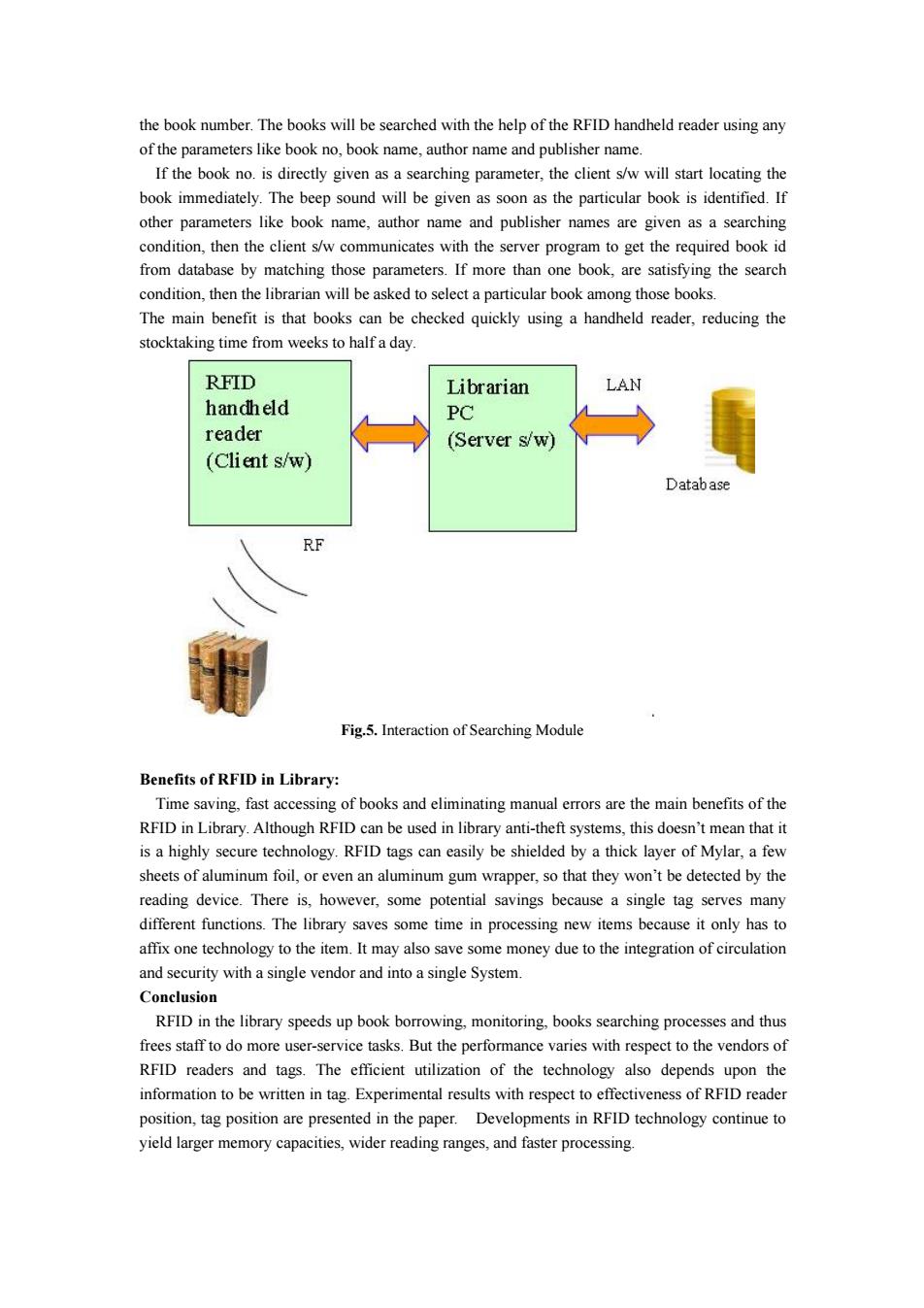正在加载图片...

the book number.The books will be searched with the help of the RFID handheld reader using any of the parameters like book no,book name,author name and publisher name. If the book no.is directly given as a searching parameter,the client s/w will start locating the book immediately.The beep sound will be given as soon as the particular book is identified.If other parameters like book name,author name and publisher names are given as a searching condition,then the client s/w communicates with the server program to get the required book id from database by matching those parameters.If more than one book,are satisfying the search condition,then the librarian will be asked to select a particular book among those books. The main benefit is that books can be checked quickly using a handheld reader,reducing the stocktaking time from weeks to half a day RFID Librarian LAN handheld PC reader (Server s/w) (Client s/w) Database RE Fig.5.Interaction of Searching Module Benefits of RFID in Library: Time saving,fast accessing of books and eliminating manual errors are the main benefits of the RFID in Library.Although RFID can be used in library anti-theft systems,this doesn't mean that it is a highly secure technology.RFID tags can easily be shielded by a thick layer of Mylar,a few sheets of aluminum foil,or even an aluminum gum wrapper,so that they won't be detected by the reading device.There is,however,some potential savings because a single tag serves many different functions.The library saves some time in processing new items because it only has to affix one technology to the item.It may also save some money due to the integration of circulation and security with a single vendor and into a single System. Conclusion RFID in the library speeds up book borrowing,monitoring,books searching processes and thus frees staff to do more user-service tasks.But the performance varies with respect to the vendors of RFID readers and tags.The efficient utilization of the technology also depends upon the information to be written in tag.Experimental results with respect to effectiveness of RFID reader position,tag position are presented in the paper.Developments in RFID technology continue to yield larger memory capacities,wider reading ranges,and faster processing.the book number. The books will be searched with the help of the RFID handheld reader using any of the parameters like book no, book name, author name and publisher name. If the book no. is directly given as a searching parameter, the client s/w will start locating the book immediately. The beep sound will be given as soon as the particular book is identified. If other parameters like book name, author name and publisher names are given as a searching condition, then the client s/w communicates with the server program to get the required book id from database by matching those parameters. If more than one book, are satisfying the search condition, then the librarian will be asked to select a particular book among those books. The main benefit is that books can be checked quickly using a handheld reader, reducing the stocktaking time from weeks to half a day. Fig.5. Interaction of Searching Module Benefits of RFID in Library: Time saving, fast accessing of books and eliminating manual errors are the main benefits of the RFID in Library. Although RFID can be used in library anti-theft systems, this doesn’t mean that it is a highly secure technology. RFID tags can easily be shielded by a thick layer of Mylar, a few sheets of aluminum foil, or even an aluminum gum wrapper, so that they won’t be detected by the reading device. There is, however, some potential savings because a single tag serves many different functions. The library saves some time in processing new items because it only has to affix one technology to the item. It may also save some money due to the integration of circulation and security with a single vendor and into a single System. Conclusion RFID in the library speeds up book borrowing, monitoring, books searching processes and thus frees staff to do more user-service tasks. But the performance varies with respect to the vendors of RFID readers and tags. The efficient utilization of the technology also depends upon the information to be written in tag. Experimental results with respect to effectiveness of RFID reader position, tag position are presented in the paper. Developments in RFID technology continue to yield larger memory capacities, wider reading ranges, and faster processing